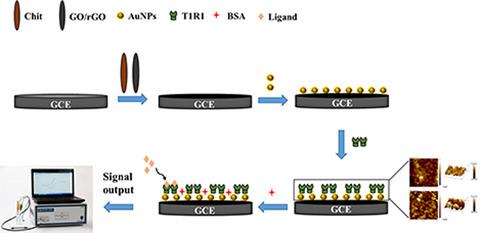当前位置:
X-MOL 学术
›
Flavour Frag. J.
›
论文详情
Our official English website, www.x-mol.net, welcomes your
feedback! (Note: you will need to create a separate account there.)
Research on sensing characteristics of three human umami receptors via receptor‐based biosensor
Flavour and Fragrance Journal ( IF 2.1 ) Pub Date : 2020-08-04 , DOI: 10.1002/ffj.3608 Weizhu Chen 1 , Yulin Huang 2 , Shui Jiang 1 , Gaole Chen 1 , Yuan Liu 1
Flavour and Fragrance Journal ( IF 2.1 ) Pub Date : 2020-08-04 , DOI: 10.1002/ffj.3608 Weizhu Chen 1 , Yulin Huang 2 , Shui Jiang 1 , Gaole Chen 1 , Yuan Liu 1
Affiliation

|
Currently, three proposed receptors, including heterodimer T1R1/T1R3, metabotropic glutamate receptor 4 (mGluR4) and metabotropic glutamate receptor 1 (mGluR1), are involved in mediating umami perception. The aim of this work was to study the sensing differences among three human umami receptors (T1R1, mGluR1 and mGluR4) without interference from other cellular signal pathways. The receptors were immobilized onto the precoated glassy carbon electrodes (GCE) to mimic cascade amplification system. The response currents towards monosodium glutamate (MSG) and disodium inosinate (IMP) were determined. The kinetic analyses showed that the allosteric constants of the interaction were as follows: KT1R1‐MSG = 7.183 × 10−12 mol/L, KmGluR1‐MSG = 1.659 × 10−14 mol/L, KmGluR4‐MSG = 7.610 × 10−15 mol/L, KT1R1‐IMP = 7.810 × 10−14 mol/L respectively. The results indicated that the sensing ability to MSG was as follows: mGluR4 > mGluR1 > T1R1. mGluRs might underly specific contribution to MSG recognition at lower concentration due to their specific structures and nerve connections. Summarily, this paper provided a novel establishment of receptor‐based biosensor, which would be useful for investigating mechanisms underlying umami signal transduction in vitro.
中文翻译:

基于受体的生物传感器研究三种人类鲜味受体的传感特性
目前,三种提议的受体,包括异二聚体T1R1 / T1R3,代谢型谷氨酸受体4(mGluR4)和代谢型谷氨酸受体1(mGluR1),都参与了鲜味感知。这项工作的目的是研究三种人类鲜味受体(T1R1,mGluR1和mGluR4)之间的感应差异,而不受其他细胞信号通路的干扰。将受体固定在预涂的玻碳电极(GCE)上,以模拟级联扩增系统。确定了对谷氨酸钠(MSG)和肌苷二钠(IMP)的响应电流。动力学分析表明相互作用的变构常数如下:K T1R1-MSG = 7.183×10 -12 mol / L,K mGluR1-MSG = 1.659×10-14 mol / L,K mGluR4-MSG = 7.610×10 -15 mol / L,K T1R1-IMP = 7.810×10 -14 mol / L。结果表明,对MSG的感测能力为:mGluR4> mGluR1> T1R1。mGluRs可能由于其特定的结构和神经连接而在较低浓度下对味精的识别产生特定的贡献。综上所述,本文提供了一种新型的基于受体的生物传感器,可用于研究体外鲜味信号转导的机制。
更新日期:2020-08-04
中文翻译:

基于受体的生物传感器研究三种人类鲜味受体的传感特性
目前,三种提议的受体,包括异二聚体T1R1 / T1R3,代谢型谷氨酸受体4(mGluR4)和代谢型谷氨酸受体1(mGluR1),都参与了鲜味感知。这项工作的目的是研究三种人类鲜味受体(T1R1,mGluR1和mGluR4)之间的感应差异,而不受其他细胞信号通路的干扰。将受体固定在预涂的玻碳电极(GCE)上,以模拟级联扩增系统。确定了对谷氨酸钠(MSG)和肌苷二钠(IMP)的响应电流。动力学分析表明相互作用的变构常数如下:K T1R1-MSG = 7.183×10 -12 mol / L,K mGluR1-MSG = 1.659×10-14 mol / L,K mGluR4-MSG = 7.610×10 -15 mol / L,K T1R1-IMP = 7.810×10 -14 mol / L。结果表明,对MSG的感测能力为:mGluR4> mGluR1> T1R1。mGluRs可能由于其特定的结构和神经连接而在较低浓度下对味精的识别产生特定的贡献。综上所述,本文提供了一种新型的基于受体的生物传感器,可用于研究体外鲜味信号转导的机制。









































 京公网安备 11010802027423号
京公网安备 11010802027423号